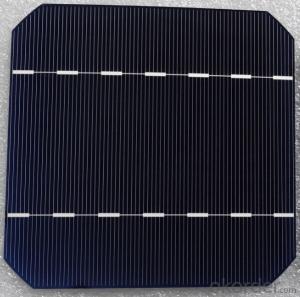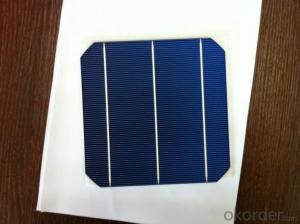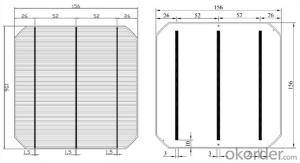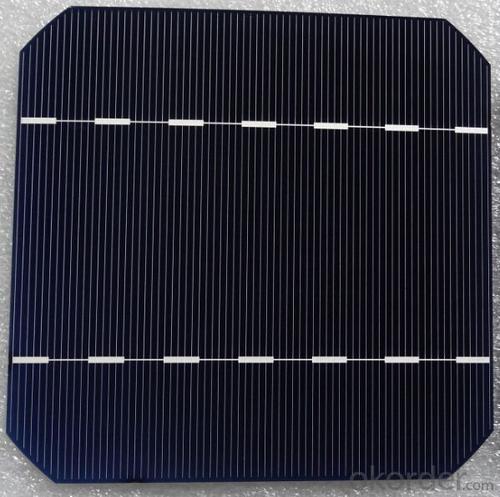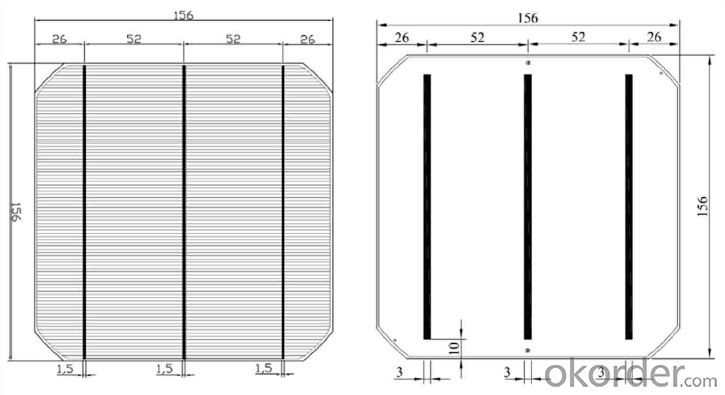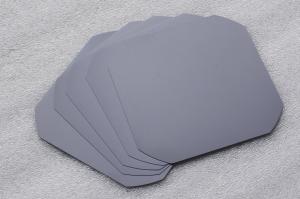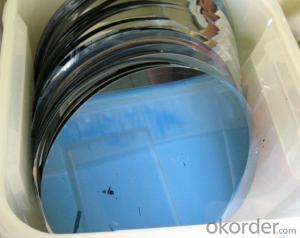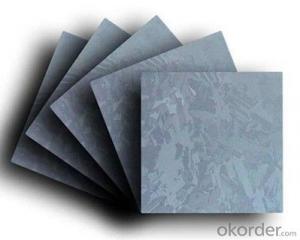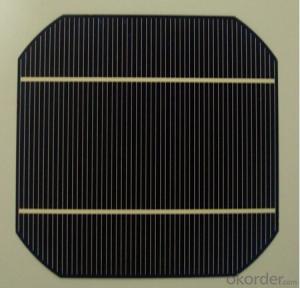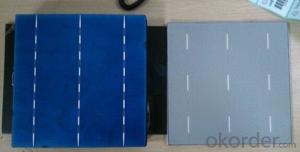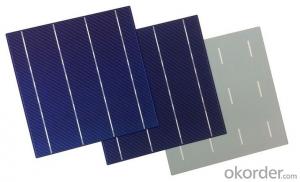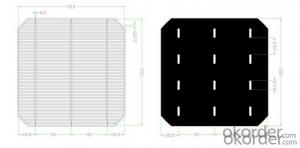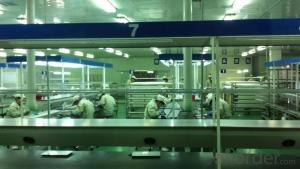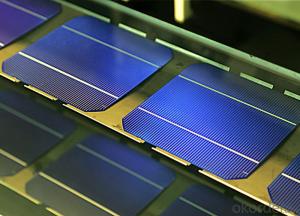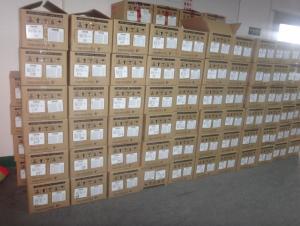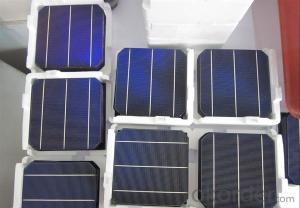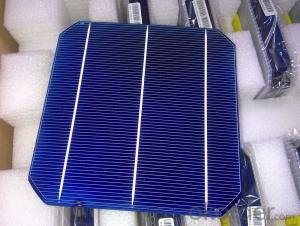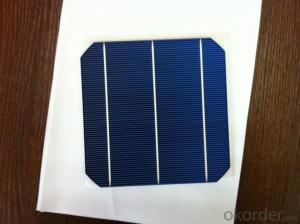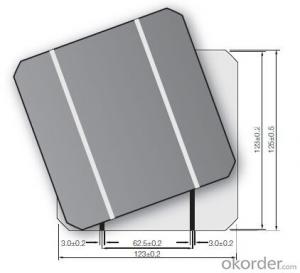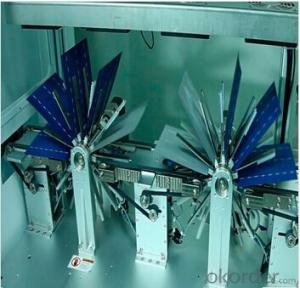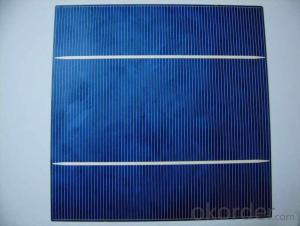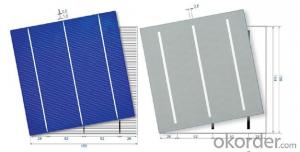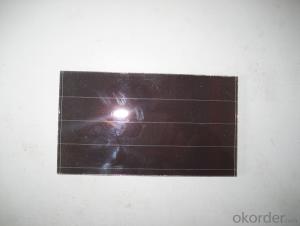A Silicon Wafer Solar Cell - Mono Solar Cells 156mm*156mm in Bulk Quantity Low Price Stock
- Loading Port:
- Shanghai
- Payment Terms:
- TT OR LC
- Min Order Qty:
- 10000 pc
- Supply Capability:
- 100000 pc/month
OKorder Service Pledge
OKorder Financial Service
You Might Also Like
Specification
Brief Introduction
- Up to 20.0% efficiency, one of the highest performing mono crystalline cells on the market
- Three bus bars boosts current collection over the entire cell area, leading to higher fill factors
- Blue anti-reflecting coating allows more sunlight be captured and converted to electricity
- Finer, closer fingers improves charge collections for improved energy yield
- Lower light-induced degradation leads to greater power output over the entire module lifetime
- All solar cells are tightly classified to optimize output of module
- Maximum yield and longevity due to hotspot prevention
- Premium appearance results in a highly uniform and aesthetically appealing module
Specification
- Product Mono-crystalline silicon solar cell
- Dimension 156 mm x 156 mm ± 0.5 mm
- Thickness 200 μm ± 30 μm
- Front 1.5 ± 0.1 mm busbar (silver)
- Silicon nitride antireflection coating
- Back 3.0 mm continuous soldering pads (silver)
- Back surface field (aluminum)
Electric performance parameters

- Testing conditions: 1000 W/m2, AM 1.5, 25 °C, Tolerance: Efficiency ± 0.2% abs., Pmpp ±1.5% rel.
- Imin : at 0.5 V
Light Intensity Dependence
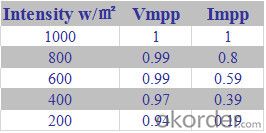
Soldering Ability
- Peel Strength: > 1.0 N/mm (Pull soldered ribbon from busbar in 5 mm/s of 180°)
Dimension Figure
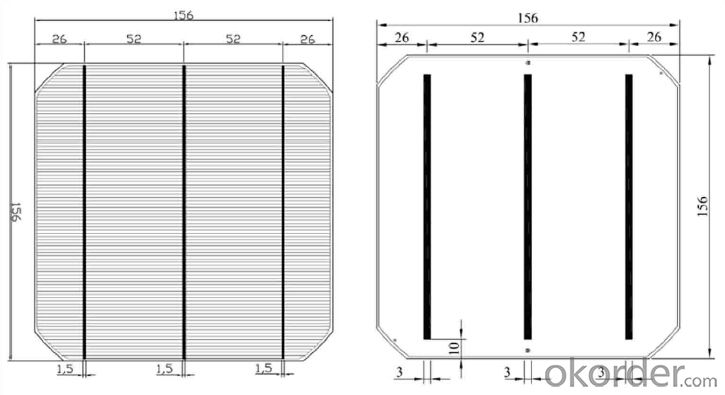
Quick Response
- Any time and anywhere, reply clients' email and solve all problems happen in the work at the first time.
- Remove clients doubts and offer the best solution at the first time.
- Give our clients the lastest news of the photovoltaic, update the newest stock informtion.
Production and Quality Control
- Precision cell efficiency sorting procedures
- Stringent criteria for color uniformity and appearance
- Reverse current and shunt resistance screening
- ISO9001,ISO14001 and OHSAS 18001,TUV Certificated
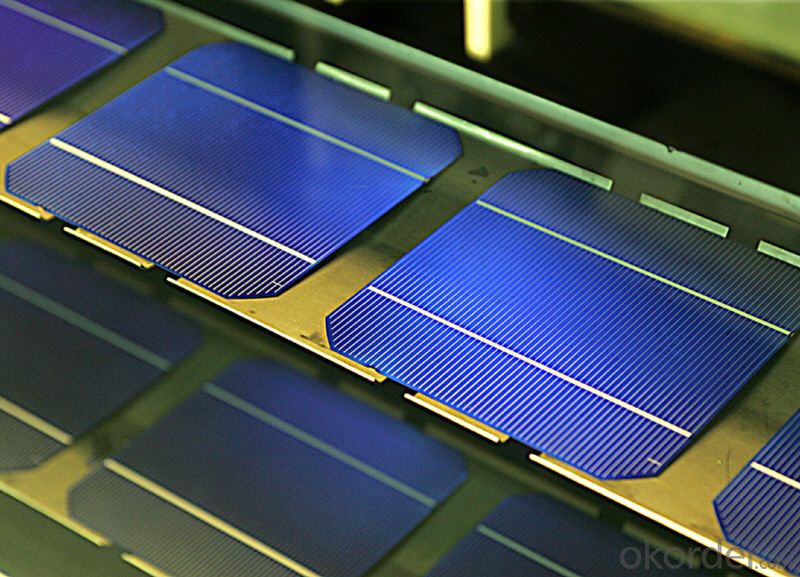
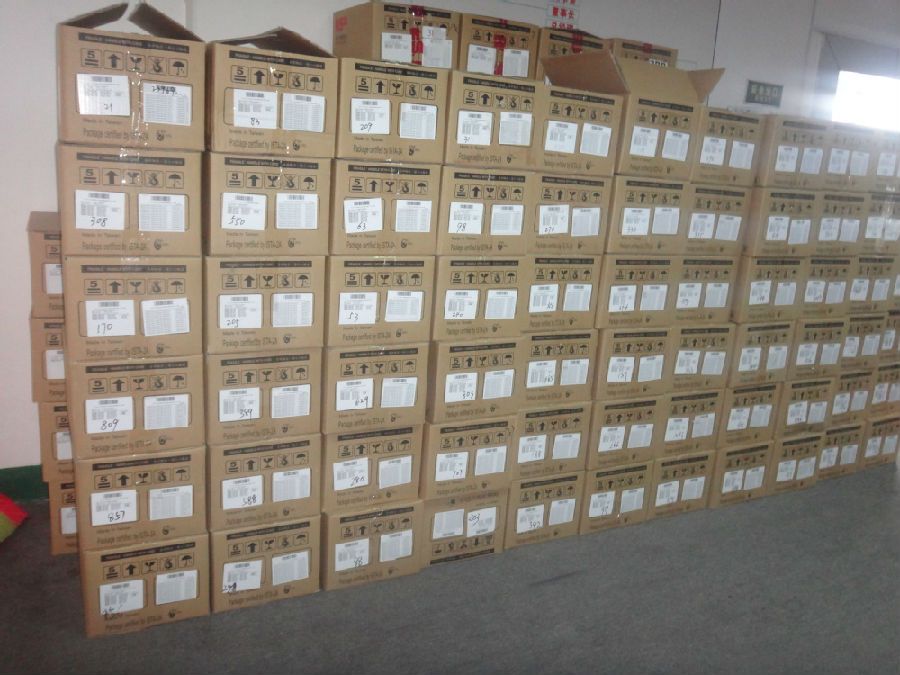
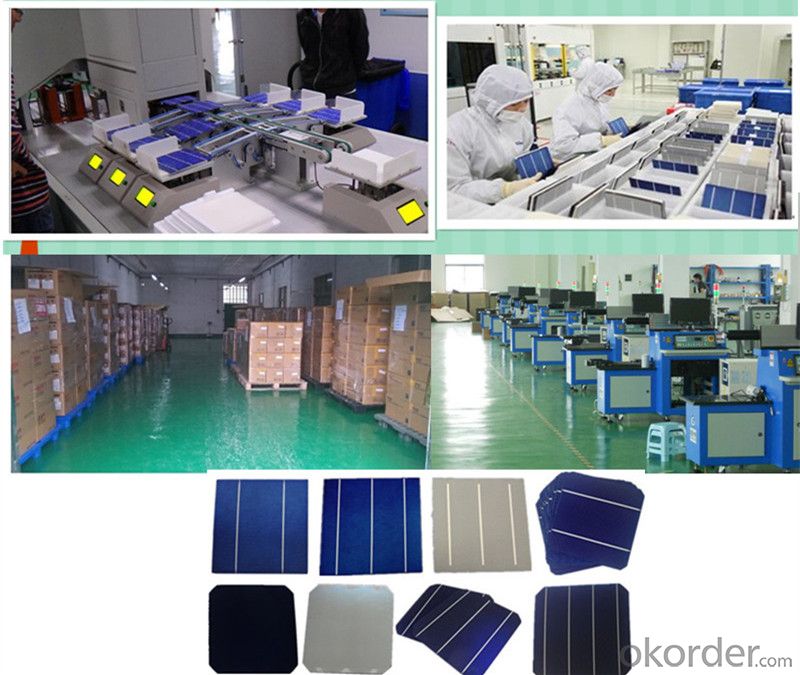
FAQ:
1. Q: Do you have your own factory?
A: Yes, we have. Our factory located in Jiangsu
2. Q: How can I visit your factory?
A: Before you visit,please contact us.We will show you the route or arrange a car to pick you up.
3. Q: Do you provide free sample?
A: Commenly we provide paid sample.
4. Q: Could you print our company LOGO on the nameplate and package?
A: Yes, we accept it.And need an Authorization Letter from you.
5. Q: Do you accept custom design on size?
A: Yes, if the size is reasonable.
6. Q: How can I be your agent in my country?
A: Please leave feedback. It's better for us to talk about details by email.
7. Q: Do you have solar project engineer who can guide me to install system?
A: Yes, we have a professional engineer team. They can teach you how to install a solar system.
- Q: What is the role of a junction box connector in a solar silicon wafer?
- The role of a junction box connector in a solar silicon wafer is to provide a secure and reliable connection between the solar cells on the wafer and the external electrical system. It allows for the efficient transfer of electrical current generated by the solar cells to the circuitry and wiring of a solar panel. Additionally, the junction box connector helps protect the electrical connections from environmental factors such as moisture, dust, and temperature fluctuations, ensuring the longevity and performance of the solar panel.
- Q: How are solar silicon wafers protected from bird droppings?
- Solar silicon wafers are typically protected from bird droppings through the use of anti-reflective coatings, which make the surface less attractive for birds to perch on. Additionally, some solar installations may utilize bird deterrents such as netting or spikes to prevent birds from landing and potentially causing damage or soiling the wafers.
- Q: What are the properties of a high-quality solar silicon wafer?
- A high-quality solar silicon wafer possesses several key properties. Firstly, it should have a high level of purity, typically above 99.9999%, to ensure minimal impurities that could affect the efficiency of the solar cell. The wafer should also have a uniform crystal structure with low defect density, enabling efficient electron flow and minimizing energy losses. Additionally, a desirable wafer should have a precise thickness, usually around 200 micrometers, to optimize light absorption and minimize material waste. Lastly, a high-quality solar silicon wafer should have a smooth surface with minimal surface roughness, allowing for effective deposition of the solar cell layers and minimizing light reflection.
- Q: How is a tracker integrated into a solar silicon wafer?
- A tracker is not integrated into a solar silicon wafer. A tracker is a separate component used in solar panel systems to maximize their energy generation by adjusting the angle and direction of the panels based on the movement of the sun. The silicon wafer, on the other hand, is the main component of a solar cell that converts sunlight into electricity.
- Q: The raw material of the solar cell is the silicon chip, some manufacturers specialize in the production of monocrystalline silicon, polycrystalline silicon chip, the production of monocrystalline silicon, polycrystalline silicon chip, what is the use of raw materials? Also ask how much raw material costs in recent years? Thank you!!
- Transistor (transistor) is a kind of solid state semiconductor device, which has many functions such as detection, rectification, amplification, switching, voltage regulation, signal modulation and so on.
- Q: Are there any advancements in solar silicon wafer surface texturing techniques?
- Yes, there have been advancements in solar silicon wafer surface texturing techniques. Researchers and engineers have been exploring various methods to enhance the efficiency of solar cells by improving the light absorption capacity of silicon wafers. Some recent advancements include laser texturing, chemical etching, and nano-imprinting techniques, which help create unique surface textures that increase the trapping and absorption of sunlight, leading to improved energy conversion. These advancements aim to maximize the performance of solar cells and contribute to the overall growth and adoption of solar energy technology.
- Q: What is the role of interconnection on solar silicon wafers?
- The role of interconnection on solar silicon wafers is to provide electrical connectivity between individual solar cells, allowing them to work together as a larger photovoltaic module. Interconnections are typically made using conductive materials such as metal ribbons or wires, which enable the flow of electricity between cells and ensure the efficient transfer of generated energy. This interconnection helps increase the overall power output and reliability of the solar panel system.
- Q: Can solar silicon wafers be used in other electronic devices?
- Yes, solar silicon wafers can be used in other electronic devices. While they are primarily used in solar panels to convert sunlight into electricity, they can also be used in various other electronic applications such as sensors, integrated circuits, and batteries. The properties of solar silicon wafers, such as their high purity and efficient light absorption, make them suitable for a wide range of electronic devices beyond just solar panels.
- Q: What is the composition of a solar silicon wafer?
- A solar silicon wafer is primarily composed of high-purity crystalline silicon.
- Q: How are solar silicon wafers protected from hailstorms?
- Solar silicon wafers are typically protected from hailstorms through the use of tempered glass covers that act as a shield. These covers are designed to be highly durable and impact-resistant, capable of withstanding the force of hailstones. Additionally, some solar panels may also incorporate anti-reflective coatings or laminates to enhance their resistance against hail damage.
Send your message to us
A Silicon Wafer Solar Cell - Mono Solar Cells 156mm*156mm in Bulk Quantity Low Price Stock
- Loading Port:
- Shanghai
- Payment Terms:
- TT OR LC
- Min Order Qty:
- 10000 pc
- Supply Capability:
- 100000 pc/month
OKorder Service Pledge
OKorder Financial Service
Similar products
Hot products
Hot Searches
Related keywords
